High Level Summary of Equality Statistics: Key Trends for Scotland 2006
The High Level Summary of Equality Statistics is a compendium which presents statistical trends on the main areas of Government activity in Scotland across a number of equality dimensions including age, disability, ethnicity, gender and in some cases religion. It provides a standardised, concise format for each topic and provides a route into more detailed statistics on each topic and each equality dimension by listing relevant publications and websites.
6. School Education
Introduction to School Education and Equality
This section of the High Level Summary of Equality Statistics ( HLSES) presents key information on school education in Scotland across a number of equality dimensions including age, disability, ethnicity and gender. It reflects key areas of activity identified in the main High Level Summary of Statistics ( HLSS) chapter on school education ( http://www.scotland.gov.uk/Topics/Statistics) from an equalities perspective and includes a few additional topics where these are particularly relevant to equality issues. The main HLSS publication presents a varied range of statistics on children and young people and these can be used in conjunction with the additional equality breakdowns shown here.
As well as showing key high level trends, the analysis highlights where differences and potential areas of inequality may exist in school education in Scotland for those groups outlined above. The analysis is not intended to provide a definitive set of equalities data and more detailed statistics across the equality dimensions, where available, are referenced in the links provided. It is also not possible to break down all topics by all equality dimensions.
There are limitations in how far some data can be broken down by the above equality dimensions. Data often contain small numbers, particularly in the case of smaller ethnic groups and to some extent disability. As such, some data show a high degree of volatility. In such instances, data may have been combined for multiple years or multiple ethnic groups, whilst in other cases data may be shown for a single year only. In other instances small data may have been suppressed in order to protect individuals' confidentiality
Possible reasons underlying the differences reported in this chapter are not detailed here. Factors which contribute to differences between equality groups represent a complex interplay of cultural, demographic and socio-economic factors and, as such, are outwith the scope of this publication.
Pupil Numbers
Pupils Numbers: Ethnic Group
In 2005, 3.80% of pupils in publicly funded schools were from minority ethnic groups, where ethnic group was known/ disclosed. The largest minority ethnic group were Pakistani (1.27%), followed by Mixed Ethnic Background (0.75%) whilst the smallest group was Black Caribbean (0.02%).
It should be noted that 3.03% of pupils did not disclose their ethnic group and this could have led to an underestimation of pupil numbers for any of the ethnic groups shown here.
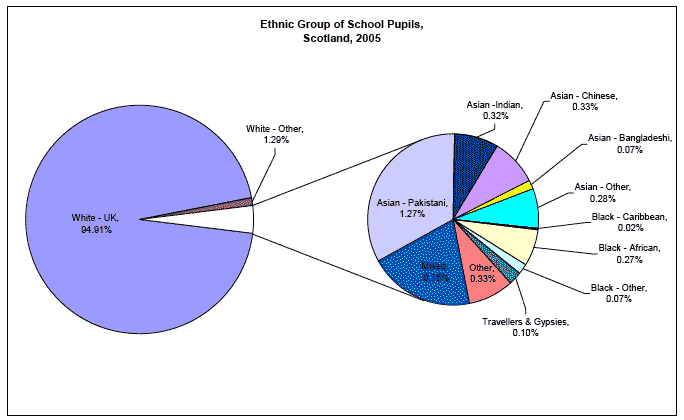
Source: Pupils in Scotland, 2005
Note: 1. Figures are based on information where ethnic group is known/ disclosed.
Publications
Analysis of Ethnicity in the 2001 Census - Summary Report http://www.scotland.gov.uk7ff5ee0f-3801-4607-b42e-2fbe7a66bf2d
Pupils in Scotland, 2005 (Published 2006) http://www.scotland.gov.uk/Publications/2006/02/28083932/0
Independent School Census, April 2006 (Published 2006 ) http://www.scotland.gov.uk/Publications/2006/04/25091645/0
Pupil Projections 2005 (Published 2005) http://www.scotland.gov.uk/Publications/2005/11/14163317/33174
Pupil Attainment
The following analysis relating to pupil attainment is based on data from the Scottish Qualifications Authority ( SQA), combined with information returned by schools as part of the annual school census. It does not recognise pupils' achievements in individual National Qualifications units and non- SQA accredited courses and it does not include achievements of pupils in special or independent schools. Further information and a full list of SQA National Qualifications are available from SQA Attainment and School Leaver Qualifications in Scotland: 2004/05 http://www.scotland.gov.uk/Publications/2006/03/09080409/0.
Pupil Attainment: Gender
Thirty-nine per cent of females and 30% of males gained 5 or more Standard Grades at credit level (or equivalent) by the end of S4 in 2004/05. These proportions have remained almost constant since 2000/01.
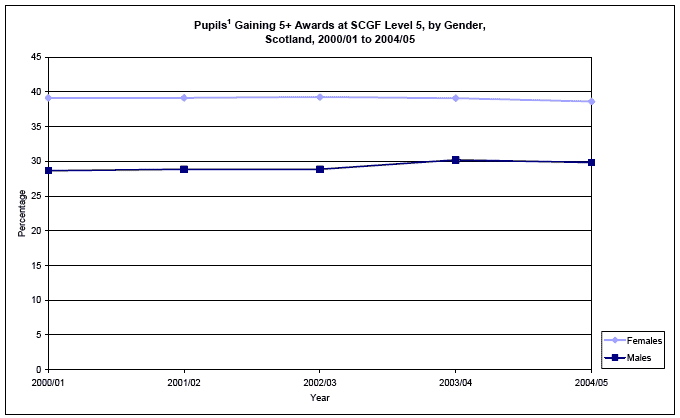
Source: SQA Attainment and School Leaver Qualifications in Scotland: 2004/05.
Note: 1. Figures are based on attainment in S4.
Publications
Social Focus on Women and Men 2002 http://www.scotland.gov.uk/stats/sfwm/docs/sfwm-00.asp
SQA Attainment and School Leaver Qualifications in Scotland: 2004/05 http://www.scotland.gov.uk/Publications/2006/03/09080409/0
Pupil Attainment: Ethnic Group & Gender
The percentage of S4 pupils gaining 5 or more Standard Grades at credit level (or equivalent) in 2004/05 was markedly higher for females from minority ethnic groups (46%) compared to females from white ethnic groups (39%). There is little difference in attainment by males in each group (around 30% of males in both groups). These proportions have remained relatively similar since 2002/03.
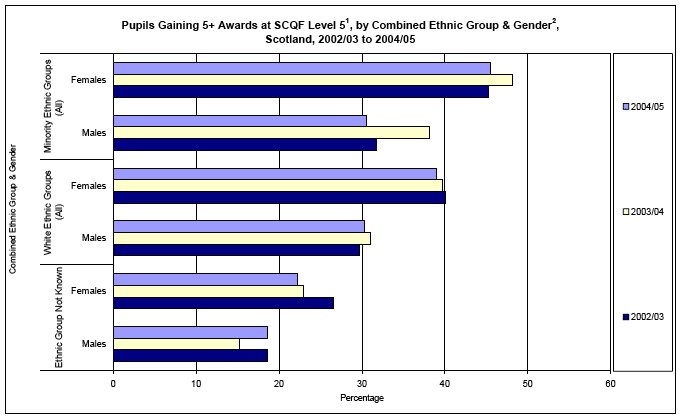
Source: SQA Attainment and School Leaver Qualifications in Scotland: 2004/05.
Notes: 1. Figures are based on attainment in S4.
2. Ethnic groups have been combined due to small numbers.
Publications
Analysis of Ethnicity in the 2001 Census - Summary Report http://www.scotland.gov.uk7ff5ee0f-3801-4607-b42e-2fbe7a66bf2d
SQA Attainment and School Leaver Qualifications in Scotland: 2004/05 http://www.scotland.gov.uk/Publications/2006/03/09080409/0
Pupil Attainment: Ethnic Group
The percentage of S4 pupils gaining 5 or more Standard Grades at credit level in 2004/05 (or equivalent) is highest for Chinese pupils (52%) and lowest for pupils whose ethnic group is not known/ disclosed (20%), followed by Black African pupils (28%). Attainment patterns have remained fairly constant across all ethnic groups since 2002/03 (where data can be disclosed 2-4).
Information on ethnic group was not known/not disclosed in all cases. For this group the proportion of pupils gaining 5 or more Standard Grades at credit level in 2004/05 is lower than for any of the ethnic groups listed. As such, the proportions shown for any of the ethnic group shown may be overestimated.
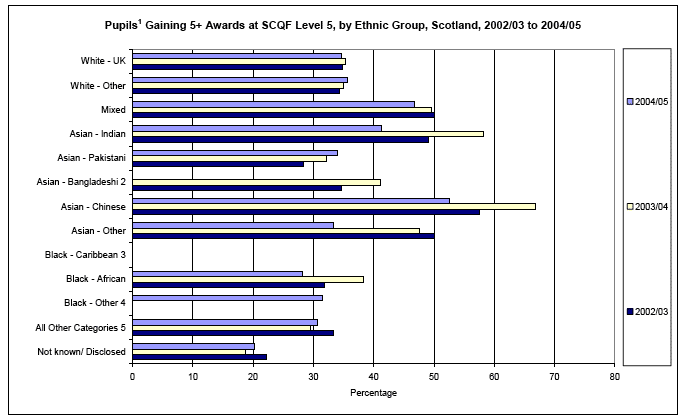
Source: SQA Attainment and School Leaver Qualifications in Scotland: 2004/05.
Notes: 1. Figures are based on attainment in S4.
2-4. For some or all years, percentages are based on less than 5 pupils have not been reported in order to protect the identity of the individuals.
5. Includes: Occupational Traveller, Gypsy/Traveller, Other Traveller and 'Other' Categories.
Publications
Analysis of Ethnicity in the 2001 Census - Summary Report http://www.scotland.gov.uk7ff5ee0f-3801-4607-b42e-2fbe7a66bf2d
SQA Attainment and School Leaver Qualifications in Scotland: 2004/05 http://www.scotland.gov.uk/Publications/2006/03/09080409/0
Pupil Attainment: Deprived Areas
The data outlined below are based on the Scottish Index of Multiple Deprivation ( SIMD) 2006.
The percentage of pupils gaining 5 or more Standard Grades at credit level (or equivalent) is 13% in the 15 per cent most deprived areas in Scotland, compared to 39% in the Rest of Scotland in 2004/05. This gap has remained almost unchanged since 2002/03.
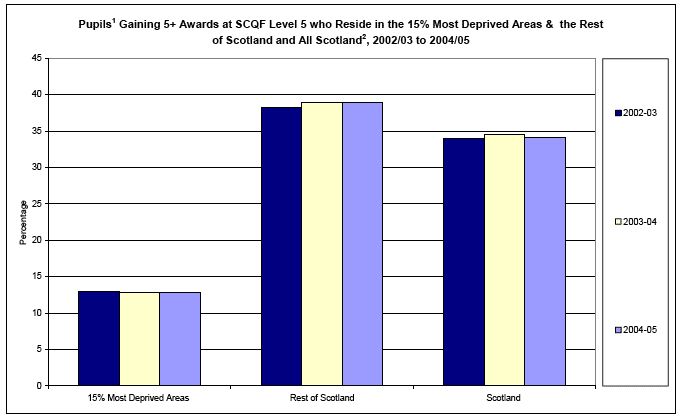
Source: Awards Data: SQA Attainment and School Leaver Qualifications in Scotland: 2004/05.
Deprived Areas Data: Scottish Index of Multiple Deprivation ( SIMD) 2006
Notes: 1. Figures are based on attainment in S4.
2. Where postcodes were not available, it was not possible to assign an SIMD rank and as such it was not possible to assign an SIMD to all pupils.
Publications
Social Focus on Deprived Areas 2005 http://www.scotland.gov.uk/SocialFocusOnDeprivedAreas
SQA Attainment and School Leaver Qualifications in Scotland: 2004/05 http://www.scotland.gov.uk/Publications/2006/03/09080409/0
Web Link
Scottish Index of Multiple Deprivation ( SIMD) http://www.scotland.gov.uk/SIMD
Average Tariff Scores of S4 Pupils
The purpose of calculating an average tariff score is to enable certifications of different types to be considered together. This makes it easier to compare average attainment for different sub-groups within the population. The tariff score of a pupil is calculated by allocating a score to each level of qualification and award, using the Unified Points Score scale. For example, a Standard Grade at level 1 counts as 38 points and at level 4 counts as 14 points. There is no theoretical maximum for tariff scores; the maximum tariff score in a year could relate to only one pupil and could, therefore be disclosive; in the past maxima have tended to be between 600-700. Further information and a full list of SQA National Qualifications and their associated tariff scores is shown in Annex A of SQA Attainment and School Leaver Qualifications in Scotland: 2004/05 http://www.scotland.gov.uk/Publications/2006/03/09080409/0
Average Tariff Scores of S4 Pupils: Gender
The average tariff score of S4 pupils is slightly higher for females (178) than for males (161) in 2004/05 and this gap has remained fairly constant since 2000/01.
The current tariff score scale does not recognise pupils' achievements in individual National Qualifications units and non- SQA accredited courses and it does not include achievements of pupils in Special Schools.
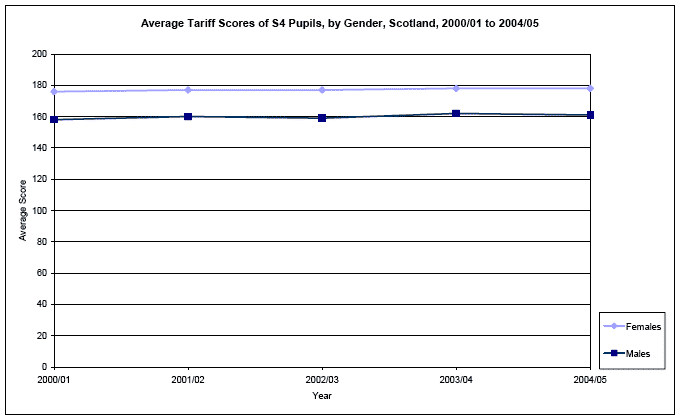
Source: SQA Attainment and School Leaver Qualifications in Scotland 2004/05
Publications
Social Focus on Women and Men 2002 http://www.scotland.gov.uk/stats/sfwm/docs/sfwm-00.asp
SQA Attainment and School Leaver Qualifications in Scotland: 2004/05 http://www.scotland.gov.uk/Publications/2006/03/09080409/0
Average Tariff Scores of S4 Pupils: Ethnic Group & Gender
The average tariff score of S4 male pupils was just over 160 for both minority ethnic groups and white ethnic groups in 2004/05. The average tariff score for female pupils from minority ethnic groups was 189, whilst it was 179 for females from white ethnic groups.
Average tariff scores for all groups have remained fairly constant since 2002/03.
The current tariff score scale does not recognise pupils' achievements in individual National Qualifications units and non- SQA accredited courses and it does not include achievements of pupils in special schools.
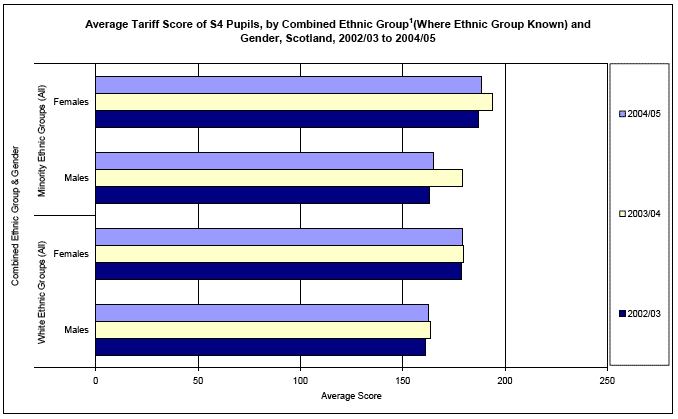
Source: SQA Attainment and School Leaver Qualifications in Scotland: 2004/05
Note: 1. Ethnic groups have been combined due to small numbers.
Publications
Analysis of Ethnicity in the 2001 Census - Summary Report http://www.scotland.gov.uk7ff5ee0f-3801-4607-b42e-2fbe7a66bf2d
SQA Attainment and School Leaver Qualifications in Scotland: 2004/05 http://www.scotland.gov.uk/Publications/2006/03/09080409/0
Average Tariff Scores of S4 Pupils: Ethnic Group
The average tariff score of S4 pupils in 2004/05 was highest for Chinese pupils (209) and lowest for Black Caribbean pupils (129). In general, there has been little variation in average tariff scores across ethnic groups since 2002/03.
The current tariff score scale does not recognise pupils' achievements in individual National Qualifications units and non- SQA accredited courses and it does not include achievements of pupils in special schools.
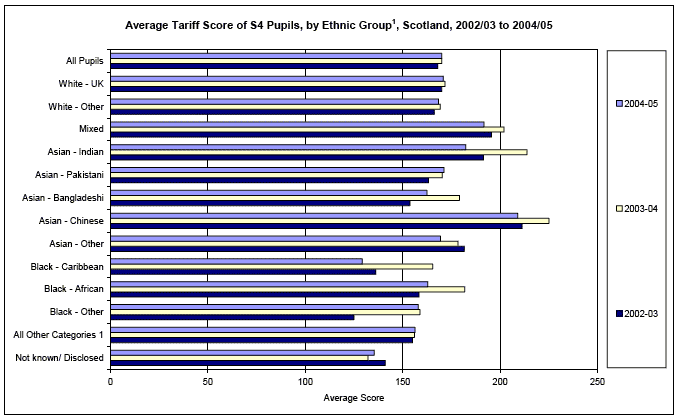
Source: SQA Attainment and School Leaver Qualifications in Scotland 2004/05
Note: 1. Includes: Occupational Traveller, Gypsy/Traveller, Other Traveller and 'Other' Categories.
Publications
Analysis of Ethnicity in the 2001 Census - Summary Report http://www.scotland.gov.uk7ff5ee0f-3801-4607-b42e-2fbe7a66bf2d
SQA Attainment and School Leaver Qualifications in Scotland: 2004/05 http://www.scotland.gov.uk/Publications/2006/03/09080409/0
Destination of School Leavers
Destination of School Leavers: Gender
Sixty per cent of female school leavers and 45% of male school leavers went on to full time further or higher education in 2004/05. A higher proportion of males went on to employment (31%) compared to females (22%), whilst a slightly higher proportion of males were unemployed and seeking employment or training (12%) than females (8%). Of those who went into training, 62% were male and 38% were female.
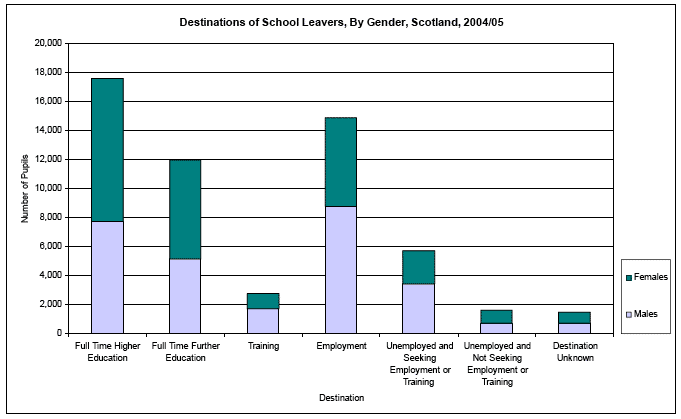
Source: Destination of Leavers from Scottish Schools
Publications
Social Focus on Women and Men 2002 http://www.scotland.gov.uk/stats/sfwm/docs/sfwm-00.asp
Destinations of Leaver from Scottish Schools: 2004/05 (Published 2005) http://www.scotland.gov.uk/Publications/2005/12/06133725/37257
Teachers
Teacher Numbers
Teacher Numbers: Gender
Female school teachers considerably outnumber males in publicly funded primary and secondary schools.
In 2004/05, female school teachers outnumber males by a ratio of 2.9:1 and this compares to a ratio of 2.7:1 in 1999/00.
The number of male school teachers has decreased by 5% from 12,858 in 1999/00 to 12,228 in 2004/05. Conversely, the number of female school teachers has increased by 3% from 34,240 to 35,333 during this period.
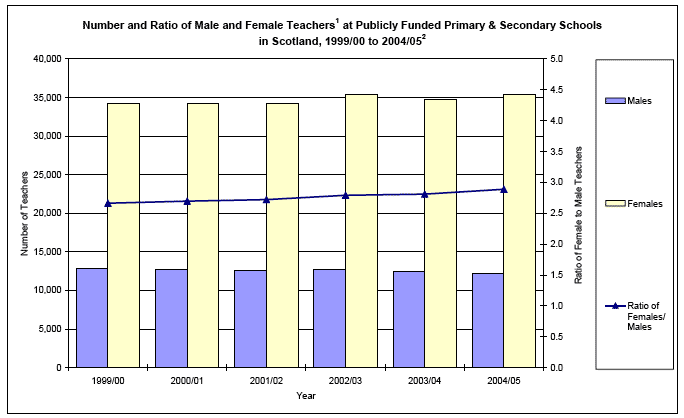
Source: Teachers in Scotland, 2005
Notes: 1. Figures are based on Full-Time Equivalent teachers.
2. Teacher numbers as at September of the academic year.
Publications
Social Focus on Women and Men 2002 http://www.scotland.gov.uk/stats/sfwm/docs/sfwm-00.asp
Teachers in Scotland, 2005 (Published 2006) http://www.scotland.gov.uk/Publications/2006/03/28083648/0
Teacher Numbers: Ethnic Group
Where ethnic group is known, primary school teachers from a minority ethnic group account for 0.5% of all primary teachers, whilst for secondary school teachers this is 1.1% in 2005. However it should be noted that these proportions may be underestimated because 4% of teachers did not disclose their ethnic group.
Number of Primary & Secondary School Teachers 1,2, by Ethnic Group, Scotland, 2005
Number
Scotland, 2005 |
||
|---|---|---|
Ethnic Group |
Primary School Teachers |
Secondary School Teachers |
White - UK |
16,802 |
14,695 |
White - Other |
361 |
586 |
Mixed |
20 |
34 |
Asian - Indian |
17 |
31 |
Asian - Pakistani |
* |
45 |
Asian - Bangladeshi |
* |
* |
Asian - Chinese |
10 |
11 |
Asian - Other |
* |
10 |
Black - Caribbean |
* |
5 |
Black - African |
* |
31 |
Black - Other |
* |
18 |
Other Ethnic Group |
23 |
53 |
Not Disclosed/ Known |
650 |
959 |
Source: Teachers in Scotland, 2005
Notes: 1. Figures do not include Head Teachers, Deputy Heads or Principals.
2. '*' Counts of less than 5 have been suppressed to protect respondent confidentiality.
Publications
Analysis of Ethnicity in the 2001 Census - Summary Report http://www.scotland.gov.uk7ff5ee0f-3801-4607-b42e-2fbe7a66bf2d
Teachers in Scotland, 2005 (Published 2006) http://www.scotland.gov.uk/Publications/2006/03/28083648/0
Teacher Numbers: Age
More than a third of male and female primary and secondary school teachers are aged between 50 and 59 years in 2005. There were fewer male and female teachers in the younger age groups, most notably those aged under 25 years.
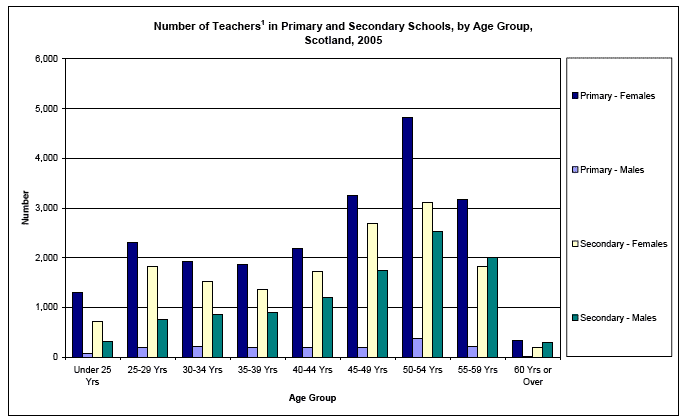
Source: Teachers in Scotland, 2005
Note: 1. Excludes teachers in grant aided schools.
Publications
Social Focus on Women and Men 2002 http://www.scotland.gov.uk/stats/sfwm/docs/sfwm-00.asp
Teachers in Scotland, 2005 (Published 2006) http://www.scotland.gov.uk/Publications/2006/03/28083648/0
Best Start for Children
School Nutrition
School Nutrition: Ethnic Group
There was marked variation in the proportion of school pupils registered for free school meals across different ethnic groups in 2005. Of all pupils, the proportion registered for free school meals was highest for pupils in the Other Traveller Group (50% of all pupils in this group), followed by 45% of Gypsy/ Traveller pupils and 43% of Other Black pupils. Only 7% of all Chinese pupils were registered for free school meals.
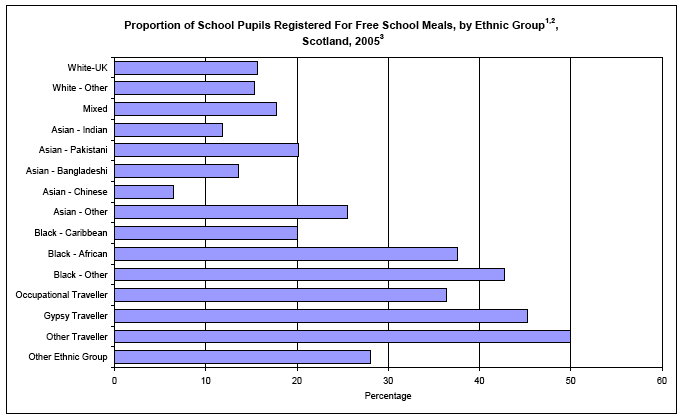
Source: Pupils in Scotland, 2005
Notes: 1. Figures are based on data where ethnic group is known/ disclosed.
2. It should be noted that percentages for certain ethnic groups are based on total counts of 150 or less.
3. Pupils entitled to free school meals are those within families who receive Income Support ( IS) or Income-based Job Seekers Allowance ( IBJSA). Those within families who receive support under Part VI of the Immigration and Asylum Act 1999 may also be entitled. Children who receive IS or IBJSA in their own right are also entitled to receive free school meals. Also entitled are children whose parents or carers receive Child Tax Credit, do not receive Working Tax Credit and have an annual income (as assessed by the Inland Revenue) of below £13,910. It should be noted that whilst pupils may be registered for free school meals, they may not necessarily take up free school meals.
Publications
Analysis of Ethnicity in the 2001 Census - Summary Report http://www.scotland.gov.uk7ff5ee0f-3801-4607-b42e-2fbe7a66bf2d
School Meals in Scotland, January 2006 (Published 2006) http://www.scotland.gov.uk/Publications/2006/06/05141444/0
Pupils in Scotland, 2005 (Published 2006) http://www.scotland.gov.uk/Publications/2006/02/28083932/0
School Exclusions
School Exclusions: Gender
During 2004-05, 79% of pupil exclusions from Local Authority schools in Scotland were males and 21% were females. Male pupil exclusions have increased from 28,510 in 1998/99 to 32,993 in 2004/05 (a rise of 16%), whilst female pupil exclusions have increased by a greater proportion (42%), though the actual increase in numbers (from 6,321 to 8,981) has been less than the 4,483 increase in the number of boys excluded.
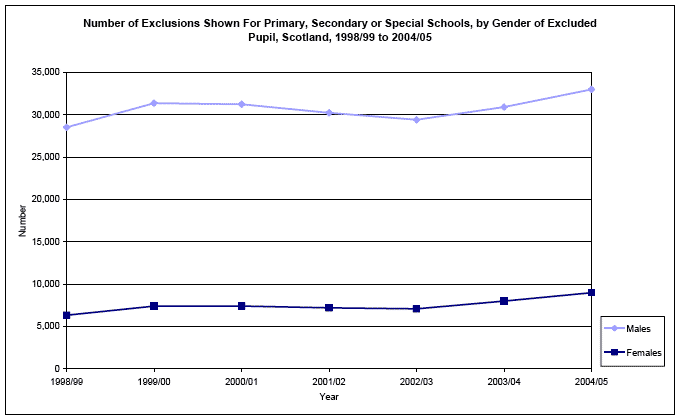
Source: Scottish Executive Education Department
Publications
Social Focus on Women and Men 2002 http://www.scotland.gov.uk/stats/sfwm/docs/sfwm-00.asp
Exclusions from Schools, 2004/05 (Published 2006) http://www.scotland.gov.uk/Publications/2006/01/30144545/0
School Exclusions: Ethnic Group
Exclusion rates vary widely across ethnic groups. The rate of exclusion per 1,000 pupils, averaged across 2003/04 and 2004/05, was highest for those in the Black Caribbean group (130 per 1,000 pupils), followed by those in the Gypsy/ Traveller group (120 per 1,000 pupils). Exclusion rates were lowest for pupils in the Chinese group (8 per 1,000 pupils), followed by those in the Indian group (15 per 1,000 pupils).
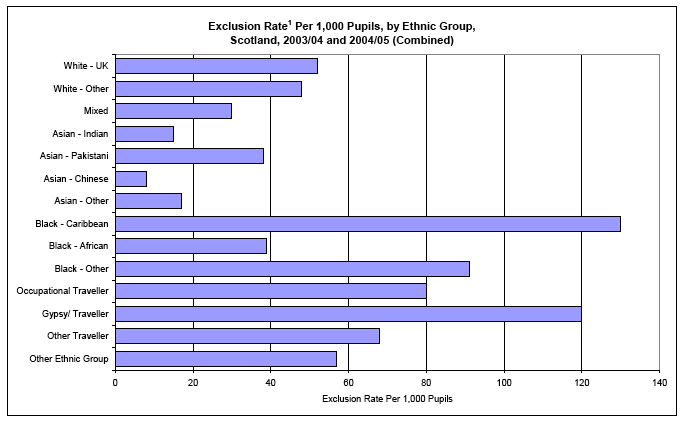
Source: Exclusions from Schools 2004/05
Note: 1. Exclusion rates may be underestimated for all ethnic groups due to the fact that information about ethnic group was not known/ disclosed by over 2,300 pupils in 2003/04 and 2004/05 (combined).
Publications
Analysis of Ethnicity in the 2001 Census - Summary Report http://www.scotland.gov.uk7ff5ee0f-3801-4607-b42e-2fbe7a66bf2d
Exclusions from Schools, 2004/05 (Published 2006) http://www.scotland.gov.uk/Publications/2006/01/30144545/0
School Inclusion
Special Educational Needs 1
Special Educational Needs 1: Gender
A markedly higher proportion of pupils with a Record of Needs (RoN) or Individualised Education Programme ( IEP) are male, regardless of the type of classes or school they attend and this is consistent over time. In 2005, 70% were male.
Of all pupils with a RoN or IEP, the majority (66%) were in mainstream classes all the time, while 23% were attending special schools or special units/ classes all the time and 11% were in mainstream classes sometimes. The 70:30 male to female ratio was constant across types of provision.
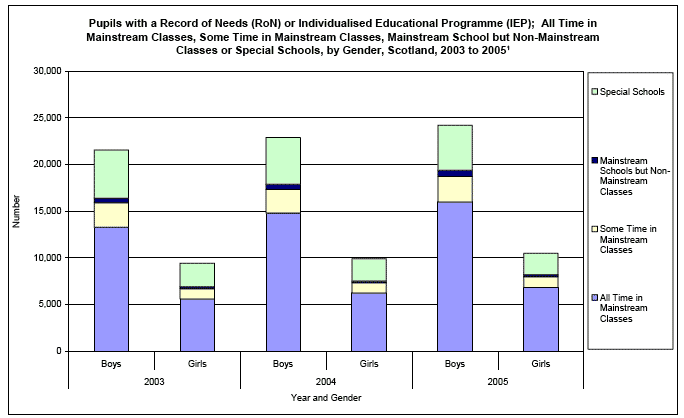
Source: Pupils in Scotland, 2005
Notes:
1. This information pre-dates the implementation of the Additional Support for Learning Act in November 2005.
Publications
Social Focus on Women and Men 2002 http://www.scotland.gov.uk/stats/sfwm/docs/sfwm-00.asp
Pupils in Scotland 2005 (Published 2006) http://www.scotland.gov.uk/Publications/2006/02/28083932/0
Learning Difficulties
The following information relates to those pupils with special educational needs where their main difficulty in learning was reported as a 'learning difficulty'. This information pre-dates the implementation of the Additional Support for Learning Act in November 2005
Learning Difficulties: Age (Children)
Of pupils with a Record of Needs (RoN) and/ or an Individualised Educational Programme ( IEP), a fairly large proportion had moderate learning difficulties (21.3%) or specific learning difficulties (20.9%) in 2005.
Between 2003 and 2005, the proportion of pupils with a RoN or IEP remained fairly constant for most types of learning difficulty.
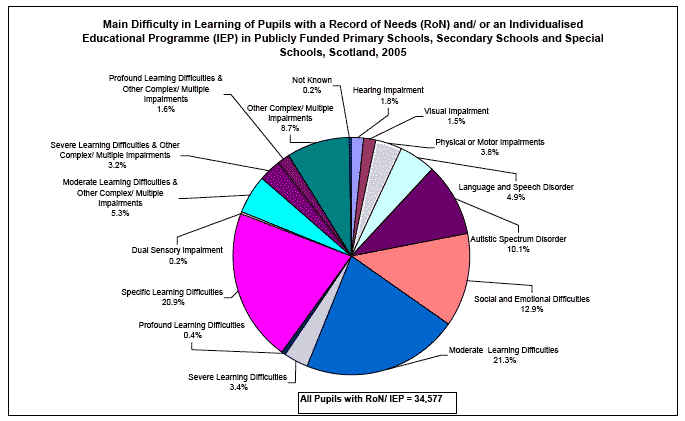
Source: Pupils in Scotland, 2003, 2004 & 2005
Publications
Social Focus on Disability 2004 http://www.scotland.gov.uk/Publications/2004/08/19818/41697
Pupils in Scotland 2005 (Published 2006) http://www.scotland.gov.uk/Publications/2006/02/28083932/0
Pupils in Schools, 2004 (Published 2005) http://www.scotland.gov.uk/Publications/2005/04/11114958/50011
Pupils in Schools, 2003 (Published 2004) http://www.scotland.gov.uk/Publications/2004/06/19559/39459
Learning Difficulties: Age
The number of pupils with a Record of Needs (Ron) or Individualised Education Programme ( IEP) for learning difficulties increases steadily with age throughout primary school, then remains constant throughout secondary school.
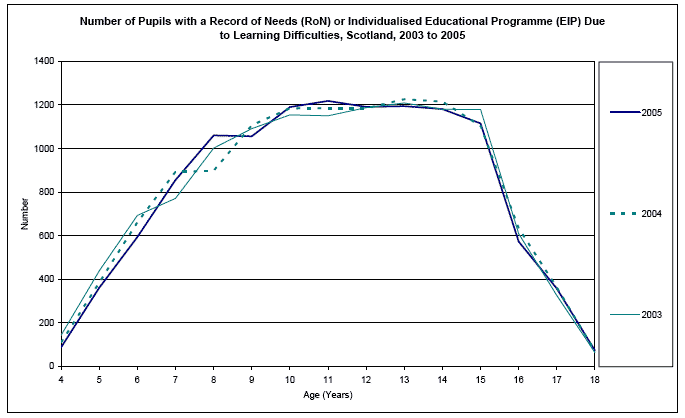
Source: Scottish Executive Education Department
Publications
Social Focus on Disability 2004 http://www.scotland.gov.uk/Publications/2004/08/19818/41697
Pupils in Scotland 2005 (Published 2006) http://www.scotland.gov.uk/Publications/2006/02/28083932/0
Pupils in Schools, 2004 (Published 2005) http://www.scotland.gov.uk/Publications/2005/04/11114958/50011
Pupils in Schools, 2003 (Published 2004) http://www.scotland.gov.uk/Publications/2004/06/19559/39459
Learning Difficulties: Ethnic Group
Of pupils based in special schools, 4.9% were from a minority ethnic background (where ethnic group was disclosed/ known) in 2005. The equivalent proportions for all pupils in publicly funded schools was 3.8%. However it should be noted that 4.4% of all special school pupils did not disclose their ethnic group and therefore the figures shown below may be underestimated for either group.
Pupils Based in Special Schools Ethnic Group (Where Known), Scotland, 2005 1
Column Percentages
Scotland, 2005 |
|
|---|---|
Pupils Based at Special Schools |
|
Ethnic Group |
% Total |
White Ethnic Groups |
95.1 |
Minority Ethnic Groups |
4.9 |
All Pupils |
100.0 |
Source: Pupils in Scotland, 2005
Note: 1. Excludes pupils in grant-aided special schools.
Publications
Analysis of Ethnicity in the 2001 Census - Summary Report http://www.scotland.gov.uk7ff5ee0f-3801-4607-b42e-2fbe7a66bf2d
Pupils in Scotland 2005 (Published 2006) http://www.scotland.gov.uk/Publications/2006/02/28083932/0
There is a problem
Thanks for your feedback